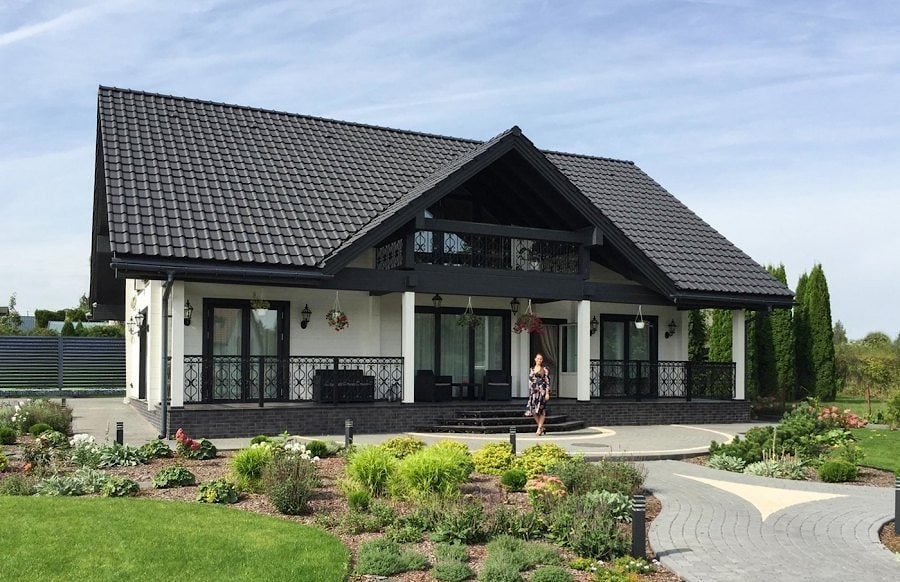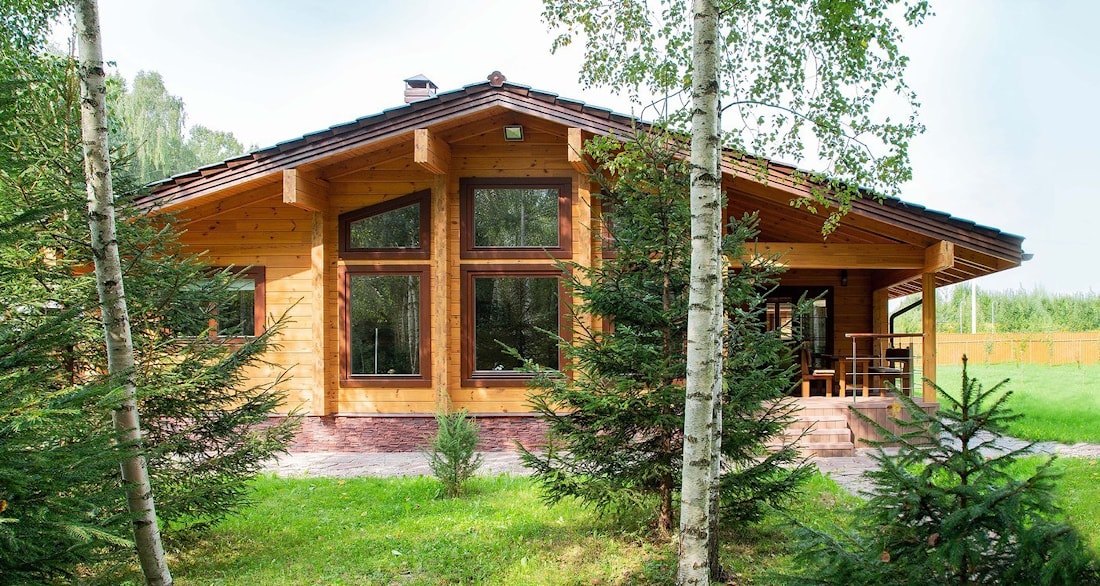≡ Menu
|
|
Heat pump for home heating
What is a heat pump for home heating? Device and principle of operation.Heat pump is a device that allows the conversion and transfer of heat from any source with a low temperature to a consumer with higher temperature parameters. The thermodynamic cycle and the principle of operation of the heat pump are identical to the chiller or air conditioner. These devices are based on the same circular process - the reverse Carnot cycle. The key difference between these devices lies directly in the designation of the equipment and the operating temperature range.These two wooden houses, "Маяк" и "Чёрный лес" built by Archiline in Belarus, are equipped with a heating and water heating system based on a heat pump and a warm water baseboard. Heating is the warmth of the earth and air! The system requires a small amount of electricity to ensure the operation of the controller. Order a house and Archiline equips it with a new unique heating system! Click on the photo, see how they look at home inside!Wooden house – "Маяк"
Wooden house – "Чёрный лес": Today, millions of heat pumps of various designs and purposes are successfully operated in the world. However, it is steam compression systems that are most prevalent in the field of heating and air conditioning of buildings. How does the heat pump work? Let us consider in more detail the principle of operation and the device of the vapor-compression heat pump. In a special heat exchanger, called an evaporator, heat is transferred from an external low-grade source of heat to the working fluid of the heat pump — the refrigerant. A low-potential source of heat for a heat pump can be any generally accessible medium with a low temperature, for example, ambient air, soil, groundwater or open water, any secondary energy source. As a refrigerant in modern heat pump installations, environmentally friendly freon mixtures are used, which have zero potential for ozone depletion (ODP = 0) and minimal global warming potential (GWP → min). So, entering the evaporator in the liquid state and under low pressure, the heat pump refrigerant receives heat from an external source and evaporates, and then in a gaseous state enters the compressor. In a heat pump compressor, freon is compressed with a sharp increase in its temperature. At the same time, the main power consumption of a heat pump accounts for the compressor power supply. After the compressor, freon compressed and heated to high temperatures, goes to the next special heat exchanger - condenser. In the condenser, the heat transferred to a high potential from the working fluid of the heat pump (freon) is transferred to the consumer - the air of the heated premises or the heat carrier (water) of the building's heating system. Transferring heat in the condenser, the freon goes back to the liquid state and, after passing through the reduction device (expansion valve), returns to the first heat exchanger-evaporator with the original parameters - low pressure and temperature. The vapor-compression cycle closes. Thus, spending only energy on the compressor drive, in the heat pump there is a conversion and transfer of heat from a source with a low temperature to a consumer with a higher potential. In this case, the heat pump is required to bring several times less energy than can be obtained at the output. 
Heat pump conversion ratioThe ratio of the amount of heat produced to the energy expended is called the conversion factor of the heat pump or the transformation ratio (denoted by COP). For modern heat pumps, the COP value can reach 5-5.5. The value СОР = 5 shows that when 1 kW of electric power is supplied to the heat pump, 5 kW of heat can be obtained.СОР is a special dimensionless quantity, which allows to evaluate the efficiency of use of a heat pump, as well as objectively compare different heat pumps with each other. It should be noted that often the COP value is confused with the efficiency of the device. However, this is not entirely true. The COP of a heat pump mainly varies in the range from 2 to 5, and the efficiency of any installation cannot be higher than 1 (more than 100%), because in every process there are inevitable losses and deviations from ideal conditions. The fact is that the value of SOR does not take into account the amount of energy that is supplied to the heat pump from a low-potential source. The magnitude of the COP reflects rather the efficiency of heat transformation from the heat source to the consumer. The heat pump allows the use of generally accessible and “free” external heat accumulated in the ground, water bodies, and ambient air. In this case, the consumer spends several times less energy only on the power supply of the installation (work directed to the conversion of heat from the source). Thus, the COP value for the consumer is accepted to be objectively used instead of the efficiency, as a quantity showing the direct efficiency of the heat pump. In practice, the value of the COP depends on many parameters. The magnitude of the COP is influenced by: the temperature of the low-grade heat source, the temperature of the heated or cooled heat carrier, the perfection of the operating cycle, the parameters of the refrigerant used, etc. Also, the energy consumption of the circulating pumps built into the heat pump is often taken into account in the COP value. Therefore, when evaluating the COP of various heat pumps, it is important to understand at what temperature parameters and by what standards the values are compared. The higher the temperature of the low-grade source used and the lower the temperature of the heated medium, the higher the performance and efficiency of the heat pump. This causes high efficiency of heat pumps with low-temperature heating systems. So, when working with radiator heating, the COP of the heat pump is approximately 3.5. When the heat pump operates with a low-temperature system, for example, underfloor heating, the COP reaches a value of 4.5–5.1. That is, in the case of underfloor heating, the heat pump will consume 30-40% less electrical energy compared to the use case of a conventional radiator system. 
Types of heat pumps, installation and operation featuresDepending on the heat source used and on the heated (cooled) medium, the following heat pumps are distinguished: air-air, air-water, water-water, ground-water, etc. Consider the features of the device and operation of the main types of heat pumps.Air-to-air heat pumpHeat pumps of this type use the energy of the most widely available source of heat - ambient air, while heating the air of heated premises. The equipment is mainly represented by low-capacity split-systems - installations that include a separate outdoor unit of the heat pump and a separate internal module (or several indoor units - a multisplit variant) that is placed indoors.In this case, the outdoor unit is connected to the internal module of the freon circuit during the installation of the equipment. The most common example of such a heat pump is a domestic air conditioner with a heating function. Such heat pumps are especially popular in countries with warmer climates, where there is no need to install a full-fledged heating system, and the heating function is needed only in short-term periods of the year. The main advantages of this type of equipment: ease of installation and relatively low cost, the ability to work in both heating mode and air conditioning mode without installing additional devices. The main disadvantage: the efficiency of the heat pump, which uses outside air as a heat source, directly depends on the temperature of the latter. In the cold period of the year at negative temperatures, when the house needs more heat, the COP of the heat pump and performance are significantly reduced and the equipment's capacity becomes insufficient for space heating. At the same time, such a heat pump always has a limitation on the temperature used - the minimum allowed outside air temperature for operation. Modern air-to-air heat pumps are capable of operating up to -25 ° C - -35 ° C. But the decrease in performance and restrictions on temperatures in the cold period of the year still do not allow the use of such heat pumps as the main source of home heating in our climate, in this case it is necessary to have a separate full-fledged independent heating system. 
Air-to-Water heat pumpHeat pumps that also use outside air as a heat source. However, for this type of heat pumps, the coolant of a water heating system or hot water supply of a building acts as a heated medium. The equipment can be presented in the form of split-systems or as a monoblock (when the heat pump is a single outdoor unit that is connected directly to the water supply system of the building), models of both small power of several kilowatts and high-capacity industrial units are produced. Can work both in the heating mode, and in the cooling mode.The efficiency of such heat pumps is comparable with the air-to-air models. The minimum operating temperature of the outside air is -25 ° C, the maximum temperature of the heated coolant is + 65 ° C. The average annual conversion factor for air-to-water systems is about 3, while in the warm period of the year, the value of the POR may be 5 or higher. Advantages: ease of installation, the ability to integrate into a common bivalent system with almost any existing source of heat, developed automation system. Disadvantages: restrictions on the temperature used, reduced performance at negative outdoor temperatures. Such heat pumps are most often used in heating and hot water systems along with traditional heat sources such as diesel, electric or gas boilers. Heat pump "Soil-water" or "brine-water"Heat pumps that use the energy accumulated in the ground as a heat source are the most expensive to install, but also the most reliable and efficient sources of heat supply among heat pump installations. Heat pumps are available in a wide power range - from compact heat pumps for private homes with a capacity of several kilowatts to cascade industrial devices with a capacity of hundreds of kilowatts.The temperature of the soil at depth remains constant throughout the year and is almost not subject to seasonal influences. Depending on the type of geothermal contour, there are heat pumps with a vertical contour — wells, and a horizontal one — with a closed horizontal contour in the ground. In the first case, U-shaped probes are lowered into the drilled wells, the number and depth of the wells depend on the heat capacity of the installed equipment. In the case of horizontal laying - geothermal collector loops fit the territory at a depth exceeding the depth of soil freezing (1.2 - 1.5 m). At the same time, the collector itself can be either a heat pump evaporator directly (copper tubes filled with freon) or an intermediate circuit between the ground and the heat pump evaporator - a system of plastic pipes filled with a coolant with a low crystallization temperature (“brine”). In practice, systems with the organization of an intermediate brine circuit have become more common. Ground-water heat pumps are also capable of working as an air conditioner in the summer, literally “pumping” heat into the ground and cooling the building. In addition to the soil, a horizontal geothermal contour can be laid on the bottom of the reservoir. Brine-water heat pumps can work not only with a geothermal circuit device, they also allow for rational use of secondary energy, for example, at enterprises, to extract heat from sewage, water supply and drainage systems, process fluids, etc. The COP of ground-water heat pumps remains virtually unchanged for the entire time of equipment operation and amounts to about 3.5 for modern installations - for high-temperature heating systems, and from 4.5 to 5 - for low-temperature heating. Advantages: the possibility of using a heat pump as the main and only source of heat supply at home, reliability, complete autonomy of the system and automation of all processes, high efficiency of work. Disadvantages: expensive installation of the vertical circuit or the need for a large area for horizontal laying geothermal collector. Water-to-water heat pumpA variety of heat pumps that allow the selection of heat from water without organizing an intermediate circuit, for example, with the installation of a system of overflow wells, or using water as an intermediate coolant instead of brine solution. Conventionally, this type of heat pump can be attributed to the previous installations of “soil-water” and “brine-water”.
Ventilation heat pumps (recuperators)As a rule, low-capacity heat pumps, specially designed for extracting low-grade heat from air with temperatures ranging from -15 ° C to + 35 ° C from the building ventilation system. In such systems, the air coming from the premises, before being discharged onto the street, first passes through the evaporator of the heat pump, transferring heat to the freon circuit. The heat pump can be used to heat the incoming air from the street, the heat carrier of the heating system or hot water supply. To date, Europe has a separate class of ventilation heat pumps for hot water supply, which allows replacing traditional electric boilers.Benefits of heat pumps· A heat pump (soil-water type) can be a full-fledged source of heat supply and air conditioning of a building along with such traditional systems as a gas, diesel or electric boiler, or work with them in a single system using a bivalent scheme (air-water type).· Autonomy of work. The heat pump automation allows you to heat the house throughout the entire heating season completely autonomously, without human intervention. · Possibility of remote control and management: modern heat pumps allow monitoring and control of a home heating system via the Internet. · Safety and environmental friendliness. The absence of fire-hazardous processes of burning of organic fuel with the advent of harmful products of combustion. · Reliability and durability. The guarantee of suppliers of heat pumps for equipment ranges from 1 to 5 years. Estimated service life of heat pump equipment - 20 - 30 years. · Silent work. In terms of noise during operation, the heat pump is comparable to a refrigerator. · Possibility of installation in any premises: the installation of a heat pump does not require a specialized room with a separate entrance, the heat pump can be installed even in the kitchen or in the bathroom. · Minimum maintenance costs: no additional costs for system maintenance during operation, except for payment for consumed electricity. · Cost effectiveness. The heat pump consumes an average of 4 times less electricity than an electric boiler of similar capacity. Operating costs are comparable to the cost of gas when operating a gas boiler. Features of the choice of the heat pumpThe heat pump is a modern efficient and environmentally friendly source of home heating. However, due to the relatively high cost of equipment (initial investment), the choice of a particular type and model of a heat pump should be approached as rationally as possible.In this case, it is desirable to make a fundamental choice of a specific heat source even before designing a home heating system. As a rule, in new homes with a heating system that is not yet existing, the choice of a “soil-water” system may be optimal. In the case of an existing main source of heat in the house, for example, a diesel boiler, the installation of an air-to-water heat pump can be a reasonable solution. When choosing the power of the installed heat pump, it is desirable to make a thermal calculation of the building envelope to clarify the heat load. After all, at home even with the same heated area may differ in heat loss by 2 times due to the design features. Having decided on the heat consumption of the building, it is necessary to assess how much of the load it is still necessary to select the heat pump equipment. It is often more correct to choose a heat pump with a capacity of 70-80% of the heat load of the building, since The maximum (calculated) amount of heat for the heating system is required only in a very short period of time in a year - at the lowest temperatures, from -24 ° C and below, which happens not so often in our climate. It is more rational to choose a heat pump of lesser capacity, significantly reducing investment in the installation, and use a peak heater for several hours a year, or invest in additional insulation of the building envelope. You can see a video-review of this house “Mirage”:We speak English, German, Turkish, French and Russian +375298-06-05-67 -- WhatsApp, Telegram, Viber Look more: Wooden house made of glued laminated timber "White House"Look more:You can see a video-review of the wooden house "Mirage":Wooden house "Mirage" from profiled glued timber 99m2If you want to buy heat pump for home heating , you can:
Call: |
|
© 2026
ArchiLine Wooden Houses
114-49, Necrasov str., Minsk, Republic of Belarus, 220049
The site is powered by Nestorclub.com google.com, pub-6447061049723989, DIRECT, f08c47fec0942fa0 | |
 Good Wooden House since 2004
Good Wooden House since 2004






